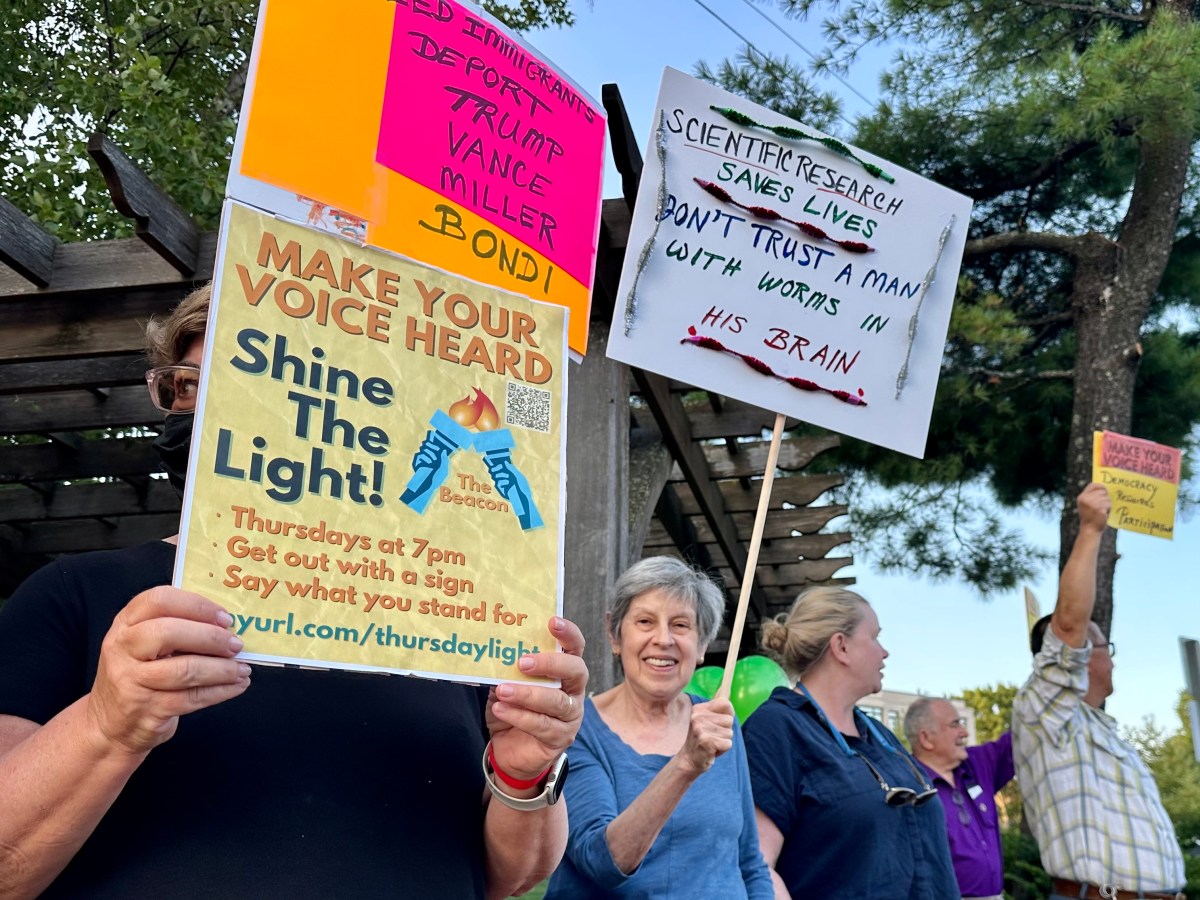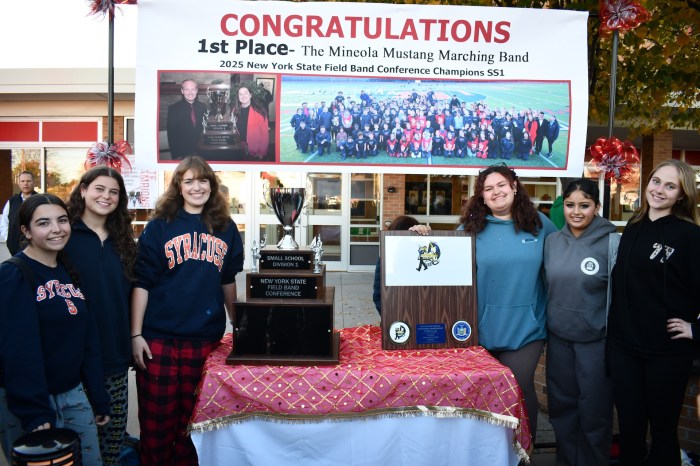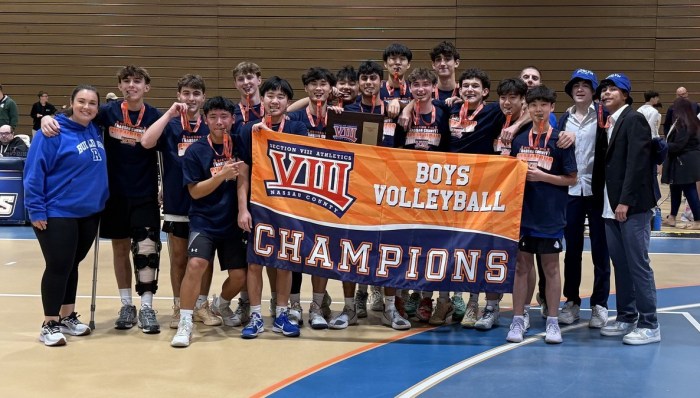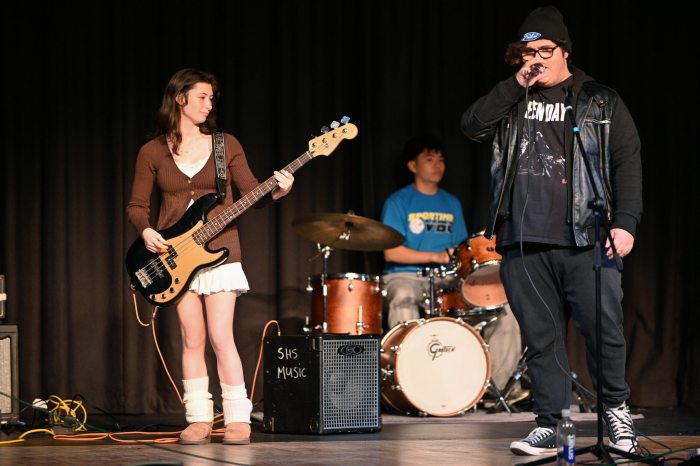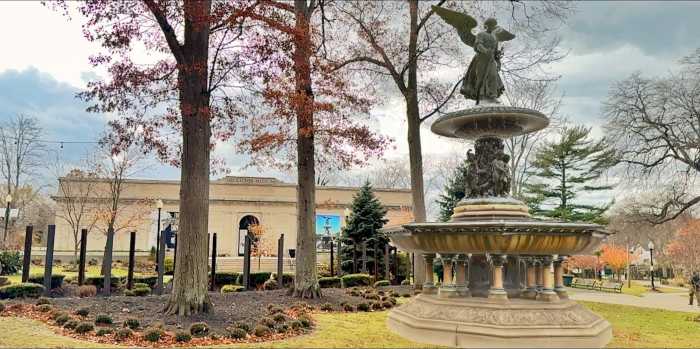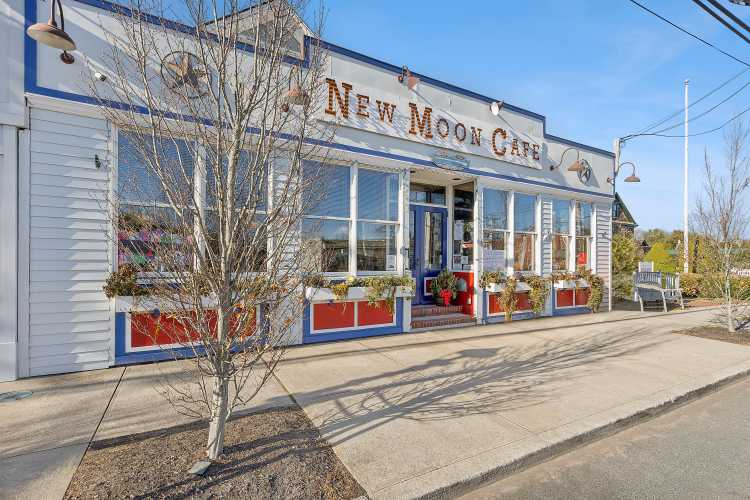Every week, once a week, for just half an hour, a group gathers across from the Great Neck Diner to make their voices heard as part of a global movement for democracy and kindness.
“We have to stand up for what we believe in, not let roll over us,” Great Neck resident Susan Savitz said.
The “Make Your Voice Heard” vigil is held every Thursday at 7 p.m., when people from across the community gather on the sidewalk with signs expressing a variety of opinions and issues.
Anyone can join, and materials to make a sign are available at every demonstration.
The weekly demonstration began with Nina Gordon, a decades-long Great Neck resident with a lifelong history of activism, and Ronald Gross, a Great Neck resident and co-chair of a Columbia University seminar. They were inspired by the national movement Shine the Light by The Beacon, a project by the Union Theological Seminary.
Shine the Light is a weekly street demonstration started by New York City-based Rabbi Sharon Kleinbaum and hosted by individuals across the country and the globe. These demonstrations, which are also held every Thursday at 7 p.m. wherever one is compelled to host it, are intended to promote solidarity among neighbors through organization and resistance.
Gordon described the demonstration as not anti-Trump, but rather pro-kindness.
“I feel like it’s important to stand, to show that people care and stand up for compassion, democracy, the rule of law, all of these things that we see being eroded in front of us,” Gordon said. “You can stay home and watch TV and yell at the newscast, or you can get out and stand there for half an hour a week and hold a sign.”
She said she was motivated to begin the demonstration to Great Neck to provide individuals a platform to express these ideals, citing a growing shift to the political right and divisiveness in the community.
“There are people that still believe in these values and are afraid to speak out,” Gordon said. “So I was motivated to just have a visible presence and show that there are people in Great Neck still that believe in these things.”
Gross said he began the gatherings in response to the current political climate.
“Basically, it was because I’m scared s——- about what’s happening to the country and where we’re headed,” Gross said. “Wherever I was, I’d be doing it.”
Gross and G0rdon said the intent is to unite neighbors and friends through advocacy.
“What I’m seeing is that people are really enjoying the camaraderie, the neighborliness,” Gross said.
The demonstration invites people to share “whatever you’re feeling in this troubling time,” the flyer states, encompassing a wide array of topics on the signs being waved. Phrases on signs included “Honk for democracy,” “Democracy requires participation” and “Scientific research saves lives, don’t trust a man with worms in his brain.”
“It’s a combination of people feeling good about expressing strong convictions that they have, that they’re feeling are threatened and hard to talk about, maybe, with friends and acquaintances and neighbors,” Gross said.
Savitz said what brought her out to the demonstration was a “danger of losing our democracy.” She said her goal was to incite change and reclaim their power in fighting back.
Demonstrator Dana Epifan was at a loss when asked why she was out there, not because she didn’t have a reason, but because she had too many.
“I feel so hopeless that there has to be something we can do, and a half an hour, once a week, is something we can do,” Epifan said.
Epifan said her goal was to raise people’s awareness of their “discontentment” with the presidential administration and promote greater political participation.
“Every day there is something horrible to listen to, and we need to have people stand up and fight for what is right,” Epifan said.
But the demonstration goes beyond sign-waving and chanting.
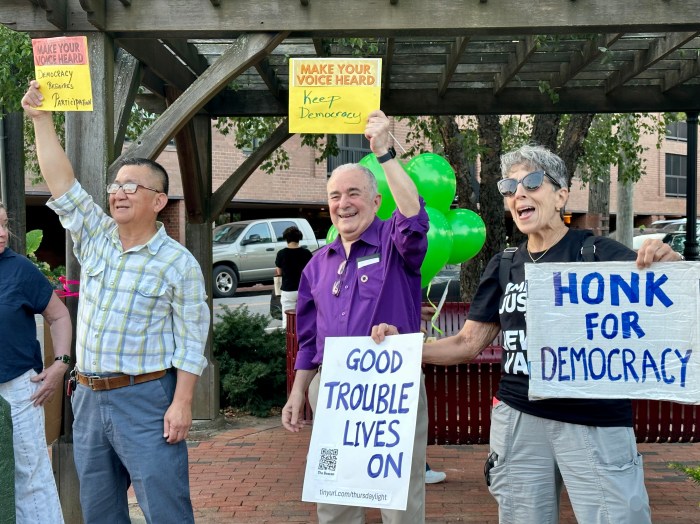
The vigils also include theatrical performances, including one conducting a dialogue between the Statue of Liberty and the red cards detailing immigrants’ rights.
Every vigil concludes with a performed reading of a poem, with a different one selected for each vigil.
At the Aug. 7 demonstration, four of its regular participants read the Maya Angelou poem “Still I Rise,” detailing individuals’ perseverance despite challenges.
While interaction between the demonstration and onlookers varies, many drive by, giving them honks of approval and a wave.
Gross calls these a “honk for democracy.”
“We get a lot of honks,” Gordon said. “It’s important to be seen. It’s important to get the message out there that people care about what is happening.”
Gross said cars passing by have been “integral” in quantifying how much awareness they are raising. During one demonstration, 311 cars passed by them during the half-hour.
“On the whole, we’ve had very good support from the public,” Gross said, pointing out that local elected officials and law enforcement have been supportive as well.
But not every interaction has been positive.
During the protest on Aug. 7, a man approached the demonstrators to dispute their claims and advocacy, filming them while he confronted them. Demonstrators responded back.
While the conversation between the two was based on disagreement, many of the demonstrators said it was still valuable to even have the chance to open this kind of dialogue.
“We don’t very often get dissenting comments, but there is a large population in this town that is very pro-Trump,” Epifan said. “We’re not going to change any minds, I don’t think that’s going to happen, but I think there’s also a large population of apathetic voters who don’t even get out and go to midterm elections or to school board elections.”
As for its future, Gross said there is no end in sight for the demonstration.
“I see them continuing as long as people come and are interested and are having fun,” Gross said.




